 December 2008
Focusing on the Affordable
Time flies. It's true! The last time I
contributed a "The Traveler" feature was in January 2007 when I wrote about a trip to Axiom Audio. It
was there that fellow SoundStage! writer S. Andrea Sundaram played a trumpet in
Axiom's anechoic chamber and we recorded it. However, shortly after that, I was sidelined
by a freak back injury that left me reeling in pain for over a year. At the time, it felt
like an eternity, but now it's a blur that went by in an instant, and all that's left are
vague memories of pain-filled days at my desk, sleepless nights, and bottle after bottle
of Advil. Now that I've recovered, I can travel freely again.
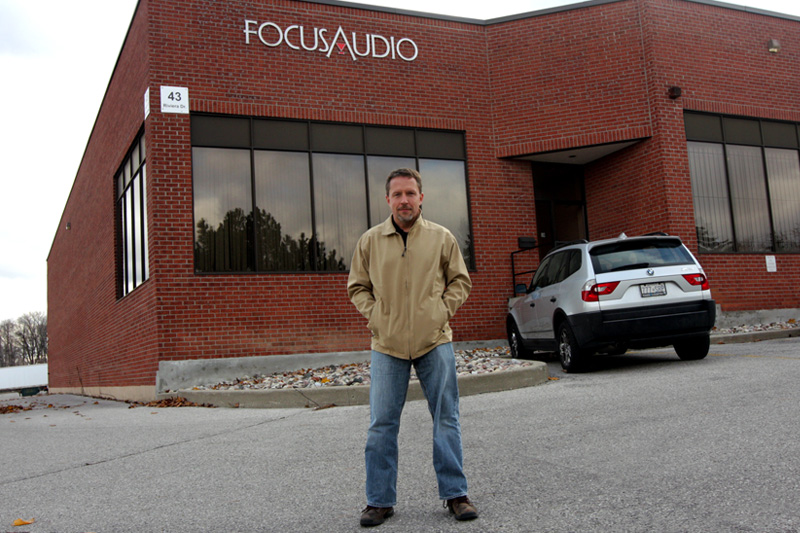
First stop: the Focus Audio factory.
Because I'm able to drive long distances
painlessly again, on a cold Monday in November I drove to someplace I hadn't been for a
while: Focus Audio in the north part of Toronto. The company has been around since 1993
and has gained an impressive reputation for building loudspeakers that not only sound good
but have a strong attention to detail in terms of parts quality as well as fit'n'finish,
including one thing that's become their hallmark: highly polished lacquer finishes that
make each speaker quite eye-catching. I've reviewed a number of the company's speakers in
the past, including three models in the Signature series -- the FS68SE, FS688 and FS788 --
as well as the Master 2.5.
The only downside to Focus's no-compromise
approach is that it has resulted in speakers that are usually quite pricey. For example,
all three models that I mentioned -- the FS68SE, FS688, FS788 and 2.5 -- currently retail
in the US for $2790, $4200, $6600 and $21,200 per pair respectively. The top model in the
Focus Audio line, which I haven't reviewed, is the Master 2; it sells for $32,500 per
pair. That's not cheap, and while Focus's speakers are not as expensive as some you can
buy, they're expensive enough that not everyone's going to be able to afford them.
But, luckily, time flies -- and things change. I
hadn't been to Focus's factory since before my injury, but from the first moment company
president and chief designer Kam Leung took me to the factory floor, I knew things were
different from the last time I was there. Different in a good way.
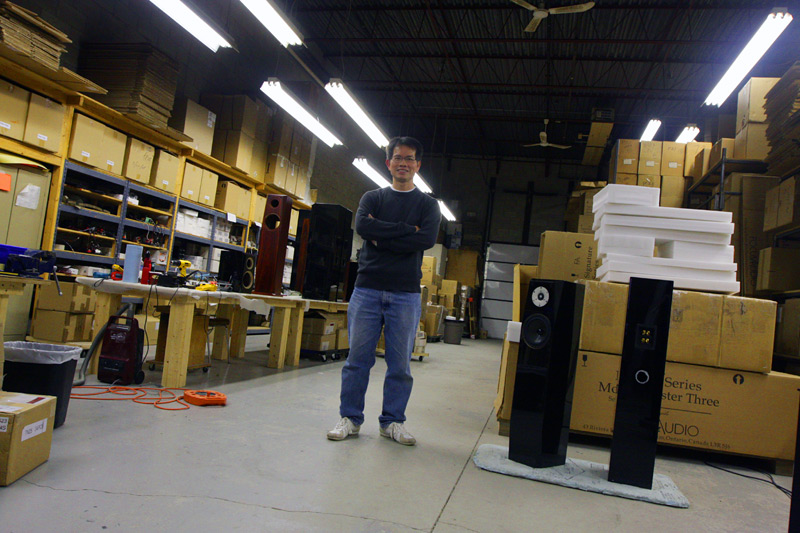
Kam Leung on Focus's factory floor.
A quick survey of the landscape revealed many new
speakers. When I pointed that out, Kam quickly handed me a current price list for all the
models. Presently, there are 16 bookshelf and floorstanding speakers, as well as two
center-channel speakers. Previously, there were about half that number.
The next thing I noticed was a new series called
Prestige, which resides below the top level, Master, and above what used to be the second
from the top, Signature. It's there to fill the large gap in price that was between the
Signature and Master lines. Right now there's only one model in the Prestige series, the
FP90 priced at $12,000 per pair. Fellow SoundStage! Network writer Jason Thorpe has a pair
in for review now. His article will appear on our Ultra Audio sister publication. Obviously, the FP90 is still a
fairly expensive speaker, so Focus is still very much into the upscale game.
However, what was more interesting to me is the
newly redesigned Classic series, which is the company's lowest-priced line. Of the 16
speakers Focus produces, four are part of the Classic line. Of the two center-channels,
one is a Classic model. The bookshelf-sized FC6 is the smallest and most affordable of the
bunch at $1030 per pair; the floorstanding dual-7"-woofered FC9 is the largest and
most expensive at $2130 per pair. The FCC2 center-channel sells for $670.
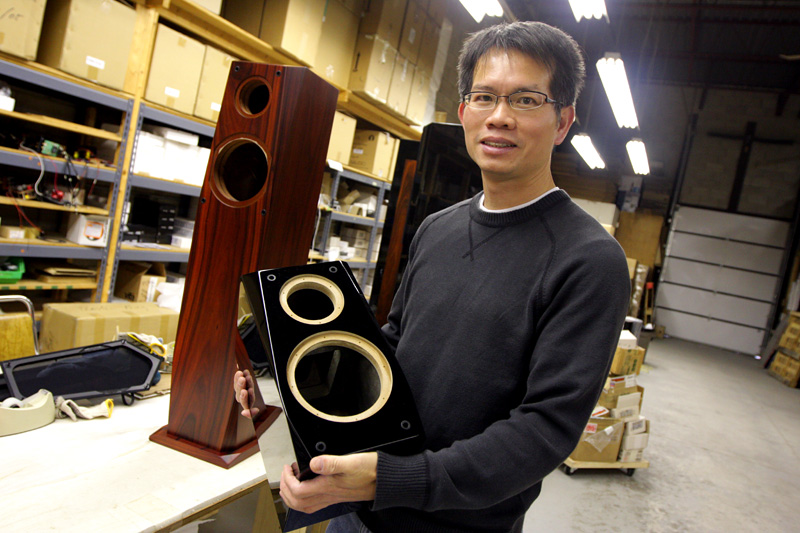
Kam with Signature (holding) and Classic cabinets
before assembly.
Despite the lower prices, attention to detail
with the Classic line seems intact, and these speakers are given the exact same treatment
as any others Focus Audio produces. Kam says that each speaker's life starts out as a
model on a computer to get the basic elements of the crossover right. But after a certain
point, real-world measurements are done to verify the results that the computer came up
with. After the company is satisfied that a certain level of objective performance has
been achieved, fine-tuning is done by ear. According to Kam, he designs all Focus speakers
to be relatively neutral (i.e., generally flat frequency response, both on- and
off-axis), which is why the computer is used and the measurements are done, but not so
neutral that they sound sterile or lifeless, which is why they're fine-tuned by ear. In
the end, he wants each speaker to be subtly distinctive and, in his words, "special
in some way."
Part of the tuning process involves tweaking the
basic crossover design in a way that alters each speaker's frequency response. But a major
part of the tuning process includes careful listening to each part that goes into the
loudspeaker for how it might affect the final sound. This is the kind of stuff that's
really tough to measure. This includes not just the drivers, but the crossover components,
wires, and even the insulation stuffed inside each cabinet. Obviously, because of the
price, the cost-no-object components that go into a Master speaker can't be used for a
Classic, but the process is still all the same despite that constraint.
The drivers in the Classic models are from
Peerless and Vifa, which Kam feels offer very good value for the money. In fact, he
pointed out some manufacturers that use the exact same drivers, but in speakers two and
three times the price, sometimes more. He encouraged me to look for myself and compare,
which, of course, I have -- and he's correct.
One thing I really like about Focus is its
no-nonsense approach to speaker design. I talked at length with Kam, and he's glad to talk
candidly about every aspect of the speakers' design, which is quite unlike some companies
that shroud their work in so much secrecy that you'd swear that what they're doing has
some sort of impact on national defense. However, all that secrecy is usually nothing more
than smoke and mirrors to cover up that there's really nothing special going on at all. In
fact, at one point during my visit, Kam jokingly said about one thing I was looking at,
"What goes inside that is magic -- 'magic' until you know what it is, then it's
not 'magic' anymore" As a result, he let me inspect every aspect of every speaker for
as long as I wanted to, and he encouraged me to photograph everything I wanted to, which I
did, a lot of which you're seeing here.
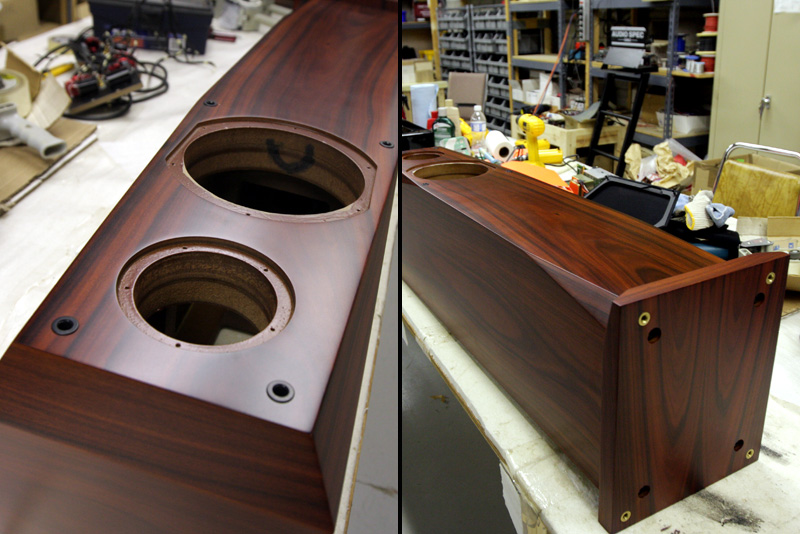
The new FC7, a two-way floorstander that retails for
$1630 per pair.
The drivers in any speaker are obviously just one
part of a larger design concept. What I think sets Classic apart has as much to do with
the cabinet, which would be impressive if the speakers were double the price. It's all
MDF, the cabinet walls are thick, and the veneer work is exceptional. I looked all around
the speaker and couldn't find a flaw. What's lacking with Classic is Focus's super-thick
lacquer, something I'll comment on below. But the end result is still spectacular, given
the price. I love the way these new speakers look. Furthermore, they're finished with
veneer on the bottom and not just painted black, indicating to me that Focus Audio doesn't
try to cut corners. Suffice it to say that, although I have yet to hear a pair of Classic
speakers, I came away from Focus thoroughly impressed with the quality of the components
and craftsmanship.
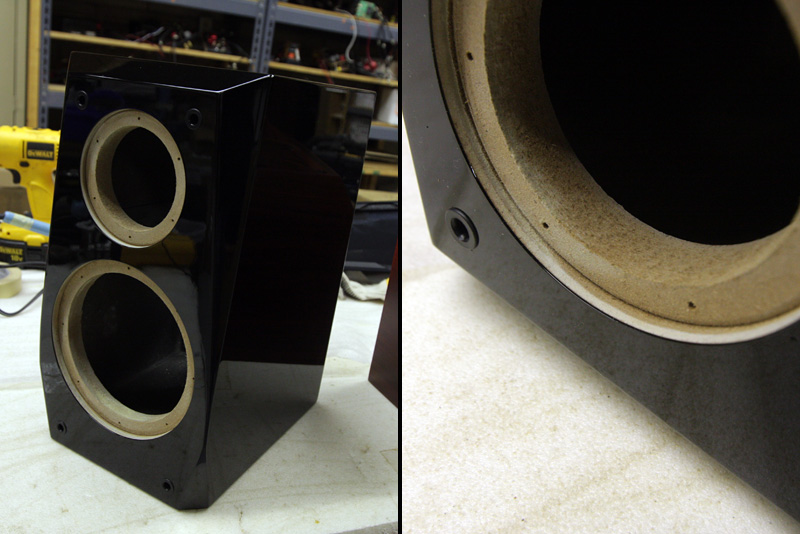
The new FS6 with a high-gloss polyester-lacquer that's
1mm thick!
Classic isn't the only series where Focus has
made things more affordable -- the price of the new Signature-series models will
undoubtedly raise some eyebrows too. Whereas the cost of entry into this line used to be
$2790 for the FS68SE, the new entry-level bookshelf model is now the FS6 and it's priced
at $1550 per pair. There is also an FS7 and FS8; both are floorstanders priced at $2500
and $2900 per pair respectively.
Whereas Classic comes with real-wood veneer, this
line comes in a high-gloss piano-black finish that features umpteen coats of
lacquer that Kam emphatically states help the speaker "sound better." When he
made that comment, though, I turned to him with a wide-eyed look, indicating that he
needed to explain what he meant, because I'll admit that I didn't believe him. "The
lacquer makes a difference?" I asked. Kam explained it to me.
In order to make his point, Kam first pointed out
the thickness of the lacquer and had me photograph it to show in this article. After that,
he told me two rather interesting points about the thickness. The first has to do strictly
with the speaker's appearance, which he describes as having "depth." Quite
simply, the lacquer is so thick that you can literally see into it, something
that results in a rich, luxurious appearance. This is in contrast to thinly applied
lacquer, which has no depth whatsoever. Ditto for automotive paints, which are used by
more and more companies to finish their speakers. Auto paint is usually quite thin,
whether it's sprayed onto a car or a loudspeaker, and it looks that way too. It has
no real depth unless a lot of clearcoat is used over the top. In contrast, putting on
layer upon layer of lacquer the way Focus Audio does gives the speaker that visual depth,
just like a superbly finished piano.
The second thing had to do with how it affects
the sound. Kam explained that polyester lacquer has good damping properties, particularly
when you use as much of it as Focus Audio does. The lacquer basically "coats"
the entire cabinet and, in turn, changes the cabinet's resonance characteristics.
According to Kam, that increased damping results in a deader-sounding cabinet that's less
obtrusive to the music. It's as simple as that -- no magic. He then knocked on a finished
and unfinished cabinet to drive home the point.
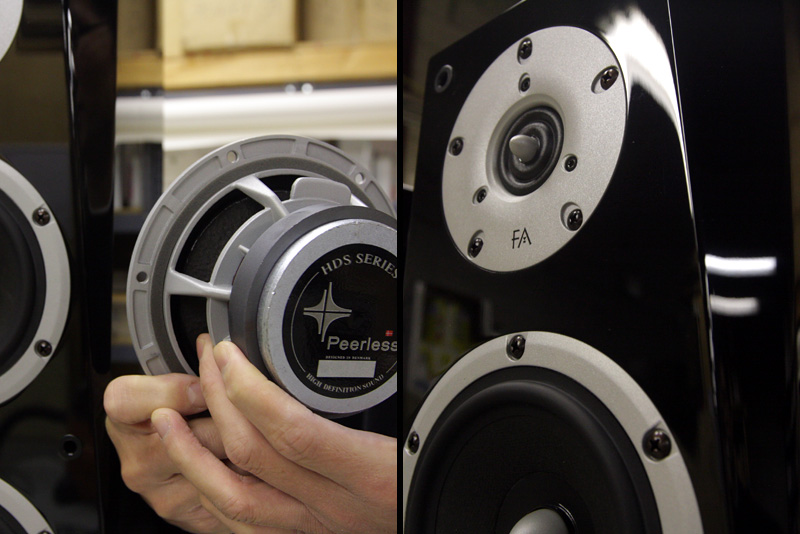
The new Signature-series speakers have Vifa tweeters
and Peerless mid-woofers.
The way they've made these new Signature-series
speakers more affordable than the older models has mostly to do with the drive units. The
older FS688, FS788, and FS888 models use Eton mid-woofers and Scan-Speak Revelator
tweeters, as do the Prestige and Master speakers. These are very expensive drivers that
some feel are the very best. These new Signature-series models use Peerless and
Vifa drivers, which Focus feels still perform to a high standard but are much more
affordable. If you look in a parts catalog, you'll find that they're half the price,
sometimes less. Hence, the big dif' in the resulting speakers' price. Again, no magic;
it's just about dollars and cents.
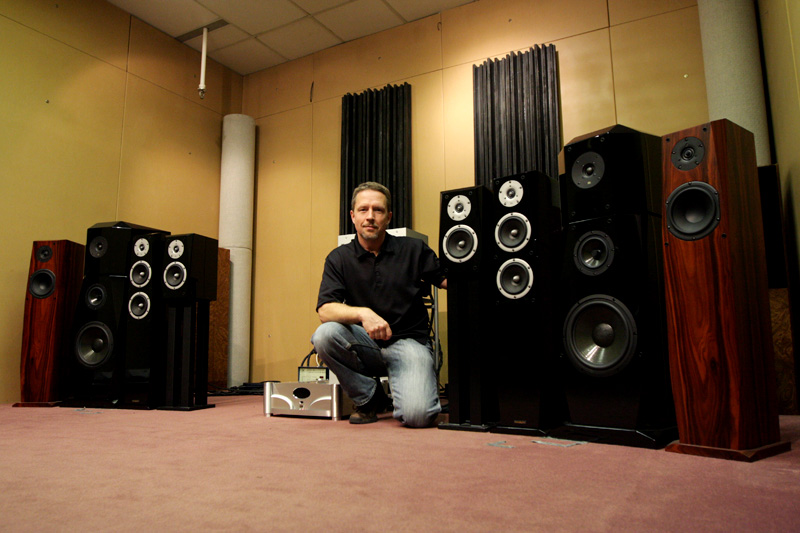
In Focus Audio's listening room.
As I mentioned, a healthy chunk of the design
time involves tuning the speaker by ear. Therefore, Focus Audio has a good listening room,
which is where I spent some time when I visited. Set up were Classic, Signature and Master
speakers -- the new Prestige speaker that would normally be in there had just been taken
to Jason Thorpe's house. Kam would have let me listen to all the speakers I wanted to, but
I chose to concentrate my attention on the speaker I planned to review: the FS8, which can
be seen in the picture above (it's the third speaker in from the right and left).
The FS8 features two Peerless 5 1/2"
mid-woofers (Focus rates the bass to 40Hz) and a Vifa ring-radiator tweeter. Its price is
$2900 per pair -- not super-inexpensive but certainly not outlandish either -- and it has
that impeccable high-gloss finish that Focus is known for. That's my kind of
speaker -- affordable but with cost-no-object workmanship. I'd also like to see us review
the FC7, which can be seen on either end of the line in the picture above. If Focus
decides to send that speaker for review, it will more than likely be written about on GoodSound!, which is our
sister site targeted at the best lower-priced stuff -- the kind of products that the bulk
of music enthusiasts can afford.
Obviously, Focus Audio understands the importance
of affordability, too. Sure, Kam and staff still have the Master series, and they've just
created the Prestige line, which, I'm told, will see more new models before too long. So,
if you have the cash, even in these dire economic times, Focus Audio will provide you a
place to spend it. But the company's most recent focus has been on making more
affordable loudspeakers that are in reach of a much larger audience. Look for a full
review of the FS8, including NRC measurements, in early 2009 -- and maybe a review of the
FC7 too.
Next stop: the Netherlands to visit Crystal Cable
and Siltech. Providing I don't injure myself again, my traveling is going to be nearly
non-stop for the next few months, and I'll be going to lots of interesting places.
...Doug Schneider
das@soundstage.com
For more information about Focus Audio, visit www.focusaudio.com.
|

